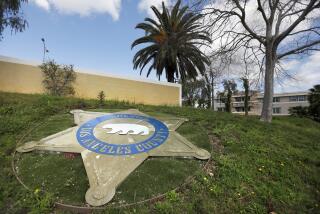High-Tech Systems Feed Change in Parking Meters
Time is running out on traditional parking meters lining curbs around Southern California. And many motorists couldn’t be happier.
Those pesky coin-gobblers that have tormented motorists since the first one popped up on an Oklahoma street 70 years ago are getting a makeover.
Soon, drivers with no change in their pocket may be able to pay to park by credit or ATM card. Those whose meter is about to expire may be able to get a text message on their cellphone warning that they face a ticket if they don’t move their car or feed the meter. That same cellphone can be used to electronically deposit more money in the meter without the motorist having to return to the street.
In a trial run in West Hollywood, the fanciest of the new meters have been installed in front of hip restaurants and boutiques along a stretch of the Sunset Strip.
The test is scheduled to last six months. But halfway through, city transportation planners were already so encouraged by the solar-powered computerized devices that they were considering asking the City Council this fall to begin permanently installing them around town.
In Pasadena, transportation managers have completed their own pilot program, in which motorists evaluated four types of high-tech parking meters. Officials are now determining which system to begin using citywide.
Los Angeles officials are planning their own evaluation of the meters in January. It will be a large-scale test, with about 200 multi-space “pay stations” from various vendors.
Many motorists are embracing the new machines with credit cards in outstretched hands. Others, however, aren’t -- saying that they’re too confusing.
“I like them. They’re very easy to use, and it’s nice to be able to use a credit card,” said Axana Leonova of Valencia as she parked in the 8600 block of Sunset Boulevard to shop in West Hollywood’s Sunset Plaza area.
Leonova pressed the pay station’s keypad and expertly followed the card-swipe instructions on the small liquid crystal display screen. A printed receipt emerged a few seconds later.
The receipt told Leonova which spot her car was parked in, how much she had paid and the exact time when the meter would expire. It also had information about adding time and a phone number to call to pay for parking.
“I’ve seen these in Europe. I’m surprised it’s taken so long for them to get here,” said the Russian-born Leonova.
Leading the Way
Even though the parking meter was invented by American Carl Magee and introduced in Oklahoma City in 1935, other countries have led the way with high-tech meters.
Most of the estimated 5 million meters in use today in the United States are still single-space models mounted on posts next to individual parking spots.
Until battery-operated electronic models became common in the 1990s, most meters had spring-operated arrows that pointed to the time remaining. Motorists wound the timing device when they turned a knob to deposit coins and make the meter’s “violation” flag drop.
Congested streets and a shortage of curbside parking prompted European cities such as London and Helsinki to adopt more sophisticated meters, beginning about a decade ago.
Most parking kiosks offer instructions in multiple languages and accept prepaid passes as well as credit cards and cash. Some promote vehicle turnover by sensing when cars have been parked longer than allowed. In 2001, cellphone payment was introduced in Finnish meters.
“It’s a technology that’s been over there many, many years. We’ve been kind of slow to pick it up,” said Amir Sedadi, Pasadena’s parking manager.
As part of his own evaluation of high-tech meters, Sedadi surveyed meter use across the United States. He found that some cities have taken baby steps toward “smart” meters -- and others big strides.
Boston experimented with 13 pay stations two years ago but held back on replacing its 7,000 single-space meters. Portland, Ore., converted 6,800 of its 8,000 parking spaces to pay stations in 2002. There have been problems with smart meters closer to home. In 2000, Newport Beach experimented with meters that used sensors to prevent motorists from continually feeding meters to hog beach-area parking spaces. The system was eventually disconnected because of repeated technical glitches, said city transportation engineer Tony Brine. Beverly Hills temporarily installed parking stations on Beverly Drive but decided to bring back traditional meters because motorists complained that the new machines were hard to use and looked unattractive.
In Pasadena, Sedadi tested four multi-space parking payment systems between October and January.
The trial run in Old Pasadena involved two metering systems: “pay and display” and “pay by space.” The first requires motorists to pay at a kiosk and then return to their cars to place a parking receipt on the dashboard. The other electronically records payments on kiosk readouts that are accessible to parking enforcement officers, obviating the need for a receipt.
Sedadi said the “pay by space” system was popular with motorists and officers alike.
About three out of every 10 motorists used credit cards to pay for their parking, he said. Cellphone capability was not included in the Pasadena test, although Sedadi thinks it is a worthwhile feature.
“You have to be signed up and you have to pay a service fee,” he said. “But once you’re established, you can pay for a certain amount of time -- say, for one hour in a two-hour zone. The meter will send out a text message to your cellphone notifying you your one-hour time is about to expire in five minutes. You have an option to call back and add more time, up to the two-hour total.”
The new meters cost between $4,000 and $9,000 each, depending on the options they offer, Sedadi said. Conventional single-space meters cost about $600.
“But you have to remember that these new multi-space pay stations can handle up to 99 spaces, or even more,” he said. “That leads to another advantage: aesthetics. You have more pedestrian walkway area. You don’t have a sea of meter heads.”
In Los Angeles, transportation planners predict that about half of the city’s 41,000 metered spaces will eventually be controlled by pay stations. Each kiosk will handle from seven to 10 spaces.
Alan Willis, principal engineer with the city’s Department of Transportation, said there would always be a place in Los Angeles for the individual meter. Some streets have relatively low meter usage; others have parking spaces that are far apart.
The city recently tested programming upgrades in parts of Westwood Village that used sensors to detect when cars pulled in and out of spaces.
In the six-week test, the meters were programmed to reset to “zero time left” when cars pulled out. In a test of enforcement effectiveness in the area, they also recorded the amount of time cars were parked in relation to the amount of time purchased. Additionally, meters in commercial loading zones were set up for deliverymen who would pre-purchase “cash keys” that could be inserted into the meters, Willis said.
Los Angeles is closely watching West Hollywood’s test, he said. Oscar Delgado, West Hollywood’s parking manager, said his 30-space test covers an area where two-hour parking is allowed. Meters charge $1 per hour.
Early on, more than half of those parking in the test area are paying by credit card, he said. But few people were signing up for the pay-by-phone cellular option, which carries a 40-cent service charge.
The West Hollywood machines are multilingual and have display screens that can be programmed to advise motorists of those times when parking is prohibited because of special events.
Adjustment Period
They take some getting used to, as Larry Guli of Thousand Oaks discovered.
“I think it’s great, but it’s confusing. Do you take your receipt ticket with you, or put it in your car? How do they know you’ve really paid?” he asked as he stopped for lunch with his wife, Margo.
Inside a nearby boutique, sales associate Valerie Lewis had a clear view of the pay station outside the front window.
“People go crazy trying to figure it out,” she said. “They don’t know how to do it, and they come in and ask me how it works. I don’t know because I walk to work.”
Across Sunset Boulevard, UCLA student Shunit Yaacobi popped in her credit card, quickly punched in the information and scooted off for lunch at Le Petit Four with classmate Katherine Neifeld.
“We’re savvy,” said Neifeld with a laugh.
But at the next kiosk over, Pablo Lazaro of San Clemente was struggling. “How do you do it? What’s the secret? I give up. It’s very confusing,” he said.
Waiting his turn behind Lazaro was Guy Botham of Hollywood. He finally coached Lazaro on how to buy an extra half hour.
*
(BEGIN TEXT OF INFOBOX)
Buying time
Los Angeles, Pasadena and West Hollywood may soon begin replacing their coin-operated parking meters with a variety of electronic kiosks. Some models can even call the driver’s cellphone to add money when time is almost up.
1. Select time needed. Meter indicates cost.
2. Pay with cash or credit/ debit card.
3. Display receipt in car window (some systems).
Source: Times research
More to Read
Start your day right
Sign up for Essential California for news, features and recommendations from the L.A. Times and beyond in your inbox six days a week.
You may occasionally receive promotional content from the Los Angeles Times.







